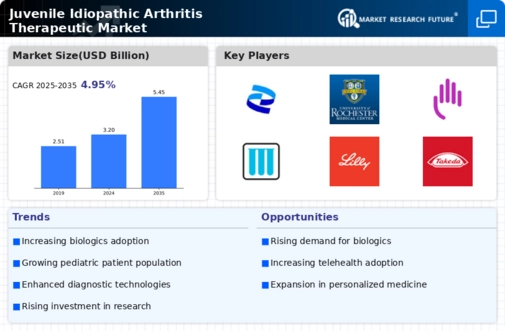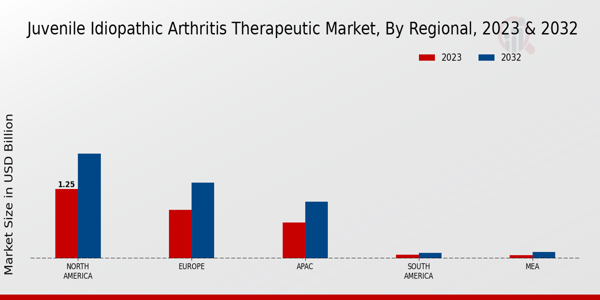Market Growth Chart
Increased Research Funding
The Global Juvenile Idiopathic Arthritis Therapeutic Market Industry is likely to benefit from increased funding for research initiatives aimed at understanding and treating JIA. Government and non-profit organizations are allocating more resources to study the underlying causes of the disease and develop new therapeutic strategies. This influx of funding is expected to accelerate the pace of clinical trials and the introduction of novel therapies. As a result, the market could see a substantial increase in therapeutic options, contributing to a projected market size of 5.45 USD Billion by 2035, reflecting the positive impact of research on treatment availability.
Growing Awareness and Education
Rising awareness and education about juvenile idiopathic arthritis are crucial drivers for the Global Juvenile Idiopathic Arthritis Therapeutic Market Industry. Various campaigns and initiatives aimed at educating parents, healthcare professionals, and the general public about JIA are fostering early diagnosis and treatment. This increased awareness is likely to lead to higher demand for therapeutic solutions, as more families seek medical assistance for their children. As educational efforts continue to expand, the market is expected to grow, aligning with the projected increase in market value to 3.2 USD Billion in 2024, highlighting the importance of awareness in driving therapeutic demand.
Advancements in Treatment Options
Innovations in treatment modalities are propelling the Global Juvenile Idiopathic Arthritis Therapeutic Market Industry forward. Recent developments in biologic therapies and targeted treatments have shown promising results in managing JIA symptoms and improving the quality of life for affected children. For instance, the introduction of new biologics has led to improved patient outcomes, which may encourage more healthcare providers to adopt these therapies. As the market evolves, the anticipated growth rate of 4.95% CAGR from 2025 to 2035 underscores the potential for continued advancements in treatment options, ultimately benefiting patients and healthcare systems alike.
Enhanced Healthcare Infrastructure
Improvements in healthcare infrastructure globally are facilitating better access to treatment for juvenile idiopathic arthritis, thereby influencing the Global Juvenile Idiopathic Arthritis Therapeutic Market Industry. Enhanced facilities, trained healthcare professionals, and improved diagnostic tools are enabling timely and effective management of JIA. As healthcare systems evolve, the availability of specialized care for children with JIA is likely to increase, leading to better patient outcomes. This trend may contribute to the anticipated growth of the market, with a projected value of 5.45 USD Billion by 2035, reflecting the positive correlation between healthcare infrastructure and therapeutic access.
Rising Prevalence of Juvenile Idiopathic Arthritis
The Global Juvenile Idiopathic Arthritis Therapeutic Market Industry is experiencing growth due to the increasing prevalence of juvenile idiopathic arthritis (JIA) among children. Current estimates suggest that JIA affects approximately 1 in 1,000 children globally, leading to a heightened demand for effective therapeutic solutions. As awareness of the condition grows, healthcare providers are more frequently diagnosing JIA, which in turn drives the need for innovative treatments. This trend is expected to contribute significantly to the market, with projections indicating a market value of 3.2 USD Billion in 2024, reflecting the urgent need for therapeutic interventions.
















